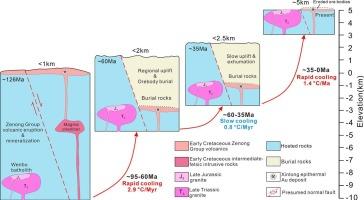Uplift and exhumation history of western Dangreyongcuo, Tibet: implications for preservation of the Xinlong gold deposit
IF 3.6
2区 地球科学
Q1 GEOLOGY
引用次数: 0
Abstract
The western Dangreyongcuo area, located in the central-northern part of the Central Lhasa terrane, has witnessed a significant breakthrough in lode gold exploration through the recent discovery of the Xinlong gold deposit within continental volcanic sequences. As a key sector for investigating the tectono-thermal evolution of the Central Lhasa terrane, its post-Mesozoic cooling-exhumation processes provide critical constraints on deciphering the Tibetan Plateau uplift dynamics and associated resource-environmental feedbacks. However, this region has received limited systematic investigation to date. This study conducts zircon and apatite (U-Th)/He dating, along with apatite fission track dating, on granites from the Wenbu batholith in western Dangreyongcuo. Integrating these results with the tectonic-thermal evolution of the Lhasa terrane, we reveal the uplift and exhumation history of western Dangreyongcuo since the Mesozoic. Thermochronological data from five samples collected across the eastern and western sectors of the Wenbu batholith yield weighted mean zircon (U-Th)/He ages between 92.7 ± 3.6 Ma and 62.7 ± 2.5 Ma, weighted mean apatite (U-Th)/He ages between 53.9 ± 3.1 Ma and 32.8 ± 1.1 Ma, and central apatite fission track ages between 63 ± 3 Ma and 56 ± 3 Ma. HeFTy modeling reveals three cooling-exhumation phases in the western Dangreyongcuo region since the Late Cretaceous: Ⅰ) Rapid cooling stage (95–60 Ma): Cooling and exhumation rates were ∼2.9 °C/Myr and ∼95.2 m/Myr, respectively, associated with Lhasa-Qiangtang terrane collision and Neo-Tethyan Ocean northward subduction. Ⅱ) Slow cooling stage (60–35 Ma): Cooling and exhumation rates decreased to ∼0.8 °C/Myr and ∼26.7 m/Myr, linked to prolonged low-elevation, slow-uplift conditions in the Central Valley. Ⅲ) Renewed rapid cooling stage (35 Ma-present): Cooling and exhumation rates increased to ∼1.4 °C/Myr and ∼47.6 m/Myr, related to Lhasa lithospheric delamination and post-∼15 Ma Miocene activity of the Dangreyongcuo Rift, both driven by ongoing India-Eurasia collision. The integration of findings from this study with low-temperature thermochronological data from the Lhasa terrane collectively demonstrates differential evolution between the eastern and central sectors within the Central Lhasa terrane, while the entire Tibetan Plateau interior has undergone significant differential uplift since the Mesozoic. The preservation of the Xinlong high-sulfidation epithermal gold deposit despite intense uplift-denudation primarily resulted from protective burial by post-mineralization Zenong Group volcanic cover and fault-induced thickening of overlying strata caused by normal fault displacement. Prolonged low-elevation conditions and slow uplift rates within the Central Valley during the Eocene enhanced the preservation potential of the orebody.

位于拉萨中地体中北部的当仁永错西部地区,近年来在陆相火山层序内发现了新龙金矿床,取得了矿脉金勘探的重大突破。然而,迄今为止,对该地区进行的系统调查有限。本文对党热永措西部文步岩基花岗岩进行了锆石、磷灰石(U-Th)/He定年和磷灰石裂变径迹定年。结合拉萨地体构造-热演化,揭示了当仁永错西部中生代以来的隆升和发掘历史。从文部基东段和西段采集的5个样品的热年代学数据显示,加权平均锆石(U-Th)/He年龄在92.7±3.6 Ma ~ 62.7±2.5 Ma之间,加权平均磷灰石(U-Th)/He年龄在53.9±3.1 Ma ~ 32.8±1.1 Ma之间,中心磷灰石裂变径迹年龄在63±3 Ma ~ 56±3 Ma之间。快速冷却阶段(95 ~ 60 Ma):冷却速率和挖掘速率分别为~ 2.9°C/Myr和~ 95.2 m/Myr,与拉羌塘地块碰撞和新特提斯洋向北俯冲有关。Ⅱ)缓慢冷却阶段(60-35 Ma):冷却和挖掘速率下降至~ 0.8°C/Myr和~ 26.7 m/Myr,这与中央山谷长时间的低海拔、缓慢隆起条件有关。Ⅲ)重新开始的快速冷却阶段(35 Ma-present):冷却和挖掘速率增加到~ 1.4°C/Myr和~ 47.6 m/Myr,与拉萨岩石圈拆沉和后~ 15 Ma中新世当热永窝裂谷活动有关,两者都是由持续的印度-欧亚碰撞驱动的。新龙高硫化浅成热液型金矿床虽有强烈的隆升剥蚀作用,但仍能保存下来,主要原因是成矿后泽农群火山盖层的保护性埋藏和正断层位移导致上覆地层的断裂增厚。始新世中央谷内长期的低海拔条件和缓慢的隆升速率增强了矿体的保存潜力。
本文章由计算机程序翻译,如有差异,请以英文原文为准。
求助全文
约1分钟内获得全文
求助全文
来源期刊

Ore Geology Reviews
地学-地质学
CiteScore
6.50
自引率
27.30%
发文量
546
审稿时长
22.9 weeks
期刊介绍:
Ore Geology Reviews aims to familiarize all earth scientists with recent advances in a number of interconnected disciplines related to the study of, and search for, ore deposits. The reviews range from brief to longer contributions, but the journal preferentially publishes manuscripts that fill the niche between the commonly shorter journal articles and the comprehensive book coverages, and thus has a special appeal to many authors and readers.
 求助内容:
求助内容: 应助结果提醒方式:
应助结果提醒方式:


